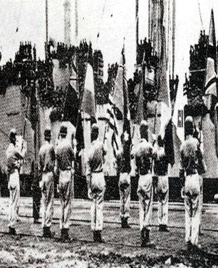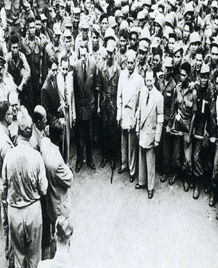 Philippines
Philippines
List for UN Allies
Background of Participation
With the UN resolution to provide military assistance to South
Korea, the Philippines offered to supply 17 tanks in July, and
to dispatch one regiment composed of 5,000 soldiers in August.
Around this time, as the necessity of UN forces rapidly
increased, the Philippine government decided to dispatch the
10th Battalion combat unit, which had the strongest war
potential.
The 10th Battalion departed from Manila Port via US transport ship on September 15th, and arrived in Pusan on September 19th. The next day, the Philippine forces landed with a warm reception by the representative of the ROK government and Pusan citizens. They were the third ground forces to enter Korea, following the US and United Kingdom.
Activity of the Ground Forces
The 10th Battalion was attached to the US 25th Division. On October 1st, it moved to Sachon, south of Jinju, in order to take over the mission of protecting the air base.As UN forces were preparing the final offensive in the Chongchon River bridgehead, the Battalion moved to Pyongyang on November 1st. The Philippine combat unit surprised the enemys hiding place on November 5th, capturing a number of North Korean soldiers and their armaments.
The 10th Battalion guarded, as a reserve unit of the US 8th Corps, the roads from Daegu through Kimchon from January 14, 1951. As the UN launched counterattacks, the Battalion moved to Pankyo and was attached to the US 3rd division. While chasing Chinese forces, the Battalion advanced to the Utah line on April 13th.
The 10th Battalion was deployed along the main resistance line at Yuldong, north of Yonchon on April 22nd. At the night, CCF attacked the Philippine soldiers, forcing them to retreat to the Kansas Line near the Hantan River. In this process, one special company had been isolated. It bravely broke through the enemys interception line and joined with the Battalion.
After the Yuldong combat, the Battalion was attached to the British 29th Brigade. On April 24th, the Battalion carried out the operation to rescue the Gloucester Battalion of the 29th Brigade, which had been enveloped by Chinese forces in Solma-ri. The Philippine soldiers failed in this operation because of enemys strong resistance. On September 5th, the 20th Battalion arrived in Pusan in early July. It took over the 10th Battalions mission. On April 29, 1952, the Philippine Battalion was deployed along the main resistance line at Kalhwa-dong on the Jamestown line. In order to repel the enemy on the T-bone Ridge, the Battalion engaged in 9 battles with CCF on the Hills of Eerie, Arsenal, and Hill 191 between the 18th and the 21st of May. Six out of the nine battles were hand-to-hand. In this series of combats, the Battalion suffered only one wounded soldier while killed 70 of the enemy. The Battalion returned home after this fighting.The third unit from the Philippines, the 19th Battalion, was deployed along the main resistance line and outpost near Kalhwa-dong on June 15th. CCF attacked the newly arrived Battalion with concentrated artillery strikes on June 20th. After a fierce hand-to-hand battle, the CCF retreated at dawn. The 19th Battalion moved to the Punchbowl at the end of January 1953. It advanced to Kachilbong on February 3rd. After small scale engagements with North Korean soldiers, the Battalion returned to Inje to be replaced by the 14th Battalion on April 3rd.
On July 9th, the 14th Battalion moved to near Mt. Backsok. It occupied blocking positions. The Battalion was severely damaged by Chinese forces disturbance fire between the 24th and the 26th of July. The Battalion had been isolated without communication and supply for 3 days. On July 27th, when the armistice agreement was signed, the enemy rained the Battalion with more than 1,000 shells. The Philippine unit suffered 20 casualties from this shelling a few hours before the armistice. But the Hill Christmas remained south of the military demarcation line as the 14th Battalion adhered to the outpost.The Philippines participated in the Korean War by dispatching 7,420 soldiers. Among them, 112 were killed and 299 wounded. The Philippine army withdrew from Korea in May 1955.


